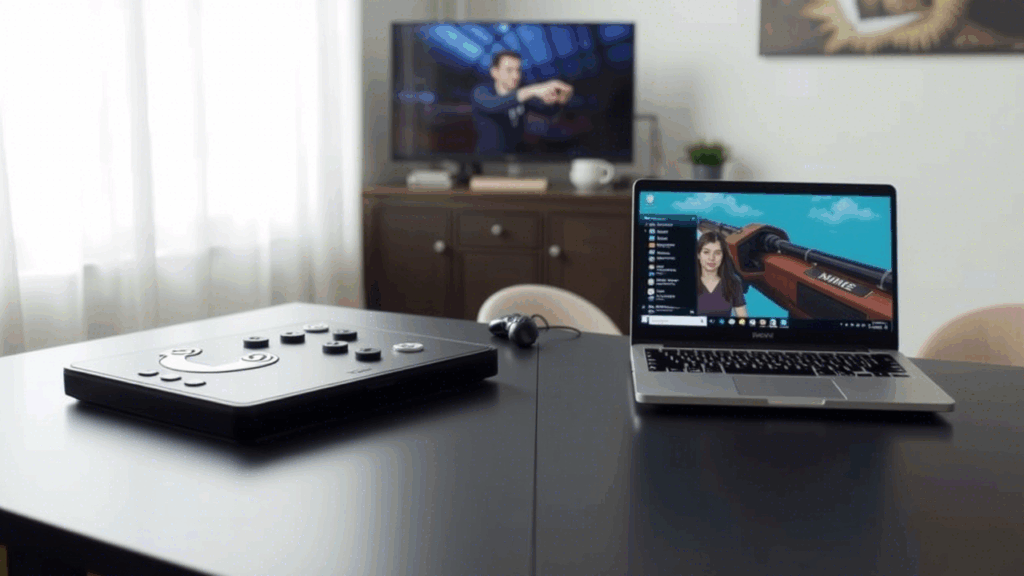Steam Deck vs. Gaming Laptop: A Calm Comparison
Choosing between a Steam Deck and a gaming laptop can feel overwhelming, especially when both offer compelling ways to play your favorite games. Rather than declaring a definitive winner, let’s take a balanced look at their strengths and weaknesses to help you decide which suits your needs best.

Portability: Handheld vs. Traditional
The Steam Deck is designed for gaming on the go—its compact, handheld form factor makes it ideal for travel, quick sessions, or lounging on the couch. It fits in a backpack easily and doesn’t require extra peripherals (unless you want them).
A gaming laptop, while portable compared to a desktop, is still bulkier. You’ll need space for the laptop itself, possibly a mouse, and maybe even a cooling pad. However, it doubles as a full-fledged PC, making it better for work, browsing, and multitasking.
Winner?
- Steam Deck for pure handheld convenience.
- Gaming laptop if you need a full computer.
Performance: Power vs. Efficiency
Gaming laptops generally offer better performance, especially higher-end models with dedicated GPUs like the RTX 4060 or above. They can handle demanding games at higher settings and resolutions.
The Steam Deck, while impressive for its size, uses a custom AMD APU. It runs most modern games well at 800p (1280×800), but you’ll need to tweak settings for AAA titles. Newer models (like the Steam Deck OLED) improve efficiency but don’t drastically boost raw power.
Winner?
- Gaming laptop for max performance.
- Steam Deck for decent performance in a small package.
Game Compatibility: Flexibility vs. Optimization
The Steam Deck runs SteamOS (Linux-based), but thanks to Proton compatibility, most Windows games work fine. Some anti-cheat games (like Fortnite or Destiny 2) may not run, and occasional tinkering is needed.
A gaming laptop runs Windows natively, meaning full access to all PC games, launchers (Epic, Xbox Game Pass, etc.), and modding tools without extra setup.
Winner?
- Gaming laptop for full compatibility.
- Steam Deck if you mostly play Steam games and don’t mind occasional tweaks.
Battery Life: Efficiency vs. Power Drain
The Steam Deck lasts 2–8 hours, depending on the game. Indie titles sip power, while AAA games drain it quickly. The OLED model improves battery life slightly.
A gaming laptop typically lasts 1.5–4 hours while gaming, even with a large battery. You’ll often need to stay near an outlet for longer sessions.
Winner?
- Steam Deck for longer unplugged play.
- Gaming laptop if you’re near power outlets.
Price: Budget vs. Premium
- Steam Deck starts at 399∗∗(LCD)or∗∗549 (OLED).
- A decent gaming laptop starts around 800–1,200, with high-end models reaching $2,000+.
If budget is a concern, the Steam Deck offers great value. But if you need a full PC, a gaming laptop justifies its higher cost.
Winner?
- Steam Deck for affordability.
- Gaming laptop if you need a full computer.
Final Thoughts: Which One Is Right for You?
Get a Steam Deck if:
✅ You prioritize portability and handheld play.
✅ You mostly play Steam games and don’t mind tweaking settings.
✅ You want a budget-friendly gaming device.
Get a Gaming Laptop if:
✅ You need maximum performance and high settings.
✅ You play games outside Steam (Game Pass, Epic, etc.).
✅ You want a full Windows PC for work and play.
Or… Get Both?
Some gamers use a Steam Deck for portable gaming and a gaming laptop/desktop for high-end play. If your budget allows, this combo offers the best of both worlds.
At the end of the day, the best choice depends on how and where you like to play. Neither is strictly “better”—just different.


